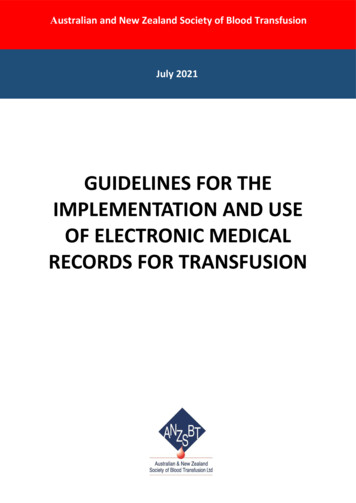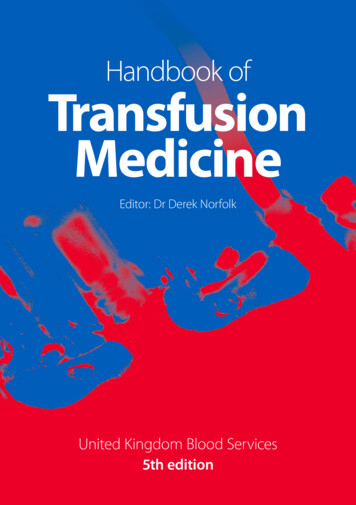
Transcription
Australian and New Zealand Society of Blood TransfusionJuly 2021GUIDELINES FOR THEIMPLEMENTATION AND USEOF ELECTRONIC MEDICALRECORDS FOR TRANSFUSION
Copyright by the Australian & New Zealand Society of Blood Transfusion LtdApart from any fair dealing for the use of private study, research, criticism, or review as permitted under theCopyright Act, no part of this book may be transmitted or reproduced in any form, electronic or mechanical, orby any information storage and retrieval system, without the written permission of the Publishers.Published in Australia by:Australian & New Zealand Society of Blood Transfusion Ltd145 Macquarie StreetSydneyNSW 2000AUSTRALIAISBN No: 978-0-9803618-9-61st Edition July 2021
Guidelines for the implementation and use of electronic medicalrecords for transfusionPrepared by the:Clinical Practice Improvement CommitteeAustralian & New Zealand Society of Blood Transfusion Ltd145 Macquarie StreetSydneyNSW 2000AUSTRALIA
ANZSBT Clinical Practice ImprovementCommittee (CPIC)Guidelines for the implementation and use of electronic medical records for transfusionii
ForewordThe Australian and New Zealand Society of Blood Transfusion (ANZSBT) Council is pleased to publish this firstedition of new Guidelines for the implementation and use of electronic medical records for transfusion whichhave been developed by the ANZSBT Clinical Practice Improvement Committee (CPIC). The increasing presenceof electronic medical records (EMR) offers a range of potential benefits to the healthcare system however theycan present a challenge to transfusion providers. These guidelines are therefore intended to assist health serviceorganisations implement safer transfusion practice using EMRs.On behalf of Council and members I wish to acknowledge the commitment of the CPIC members who providedtheir time and expertise in developing these guidelines. The ANZSBT’s library of guideline documents are widelyaccepted and I am confident that these new guidelines will similarly prove to be an extremely valuable additionto the Australasian transfusion community.Simon BensonPresidentANZSBTJuly 2021Guidelines for the implementation and use of electronic medical records for transfusioniiii
ContentsANZSBT Clinical Practice Improvement Committee on2Section 1The decision to transfuse3Section 2Consent for blood products4Section 3Prescription of blood products5Section 4Requests for blood products and pretransfusion sample collection6Section 5Storage, collection and transport of blood products7Section 6EMR assisted administration of blood products8Section 7Special transfusion circumstances10Section 8Transfusion-related adverse events11Section 9Clinical governance12Glossary15References16Guidelines for the implementation and use of electronic medical records for transfusion1
AbbreviationsACSQHCAustralian Commission on safety and Quality of Health CareANZSBTAustralian and New Zealand Society of Blood TransfusionEMRElectronic Medical RecordsISBTInternational Society of Blood TransfusionPBMPatient Blood ManagementRFIDRadiofrequency identificationLISLaboratory information systemGuidelines for the implementation and use of electronic medical records for transfusion1
IntroductionElectronic medical records (EMR) have the potential to improve delivery of health care. Reported benefitsinclude improved continuity of care, increased efficiency of rapid call responses with reduced intensive careadmissions and hospital mortality, improved data accuracy and integrity, improved event monitoring andadverse events monitoring.1,2 Medication management software may reduce medication errors3,4 and intransfusion, barcode or radiofrequency identification (RFID) may reduce errors in patient identification, both atthe time of transfusion and at the point of blood collection.5-8 Biometric data have been used in the same way,but have limitations due to the storage of this information in many jurisdictions.9 EMRs may also improve clinicaltransfusion practice by the integration of physician decision support tools at the time of order entry10-15 andmonitoring of observations.16 Detection of adverse transfusion reactions and decision support for managingreactions is a further, as yet unrealised, opportunity for EMRs.17Improvements are not universal. Errors may occur relating to systems failure, transitions between written ormanual processes and the EMR and failure of interactions between the system and users.18,19 Clinicianworkarounds may offset potential benefits of identification safety systems.20 Clinical content, the computerhuman interface and human factors are responsible for the largest proportions of contributing factors forreported medication safety events.21 Health care services and vendors need to consider safety and workflowintegration of any proposed hardware and software solutions, promoting best practice, especially in matters ofsafety. Implementation and use of electronic medical records need to ensure compliance by the electronicsystem itself and consider the integration into the process and human systems of the health care services.It is important to recognise that electronic records at the patient’s side per se does not make transfusion processsafer. Improvement in patient safety has led to recommendations for their use, but cost limitations, with a largeamount of specific infrastructure required, have limited the rate of implementation. There are many aspects tothe transfusion process and a particular EMR implementation may serve only to passively document or mayactively integrate to improve safety. Integrating transfusion, EMR and medication management systems maycreate efficiencies, shaping safe practice rather than just recording care. To enable this, compatibility at all stepsin the process requires significant integration between information technology systems, both software andhardware, as well as the human factors in the healthcare environment. Where a system is perceived by usersas contributing to safety, but is not designed to do so, risks are potentially increased.Transfusion specific solutions for patient identification have been developed and implemented for more than 20years22,23 along with guidance on implementation.24 Electronic systems that assist patient identification from thepatients’ side, through the laboratory and back, reduce identification errors and sample recollections.2,5-7,25-27 Theymay also improve data integrity and product traceability,28 if appropriately designed and implemented to ensurethe correct identity of the patient and their intended blood product, the need for a second person to conduct anindependent double check may be safely withdrawn, leading to improved efficiency.There is very little guidance on the use of EMR to assist transfusion-related processes. International guidancefor RFID in transfusion are available, and highlight the need to consider RFID integration into business processes,not just as stand-alone technology.29 Recommendations from the Japan Society of Transfusion require that atwo person check be undertaken pre-transfusion, and that the electronic check is additional to that just prior totransfusion.30 While this is a safe approach, it precludes the realisation of efficiencies, without compromisingsafety, that may be achieved with some EMR systems.ScopeThis guidance is to help services implement safer transfusion practice using EMRs. It defines the requirementsfor systems where the EMR can be used as the second independent checker for blood product administration.One person, authorized to do so by the health service, can perform the checks with the EMR and appropriatesoftware at the bedside. It also outlines important safety considerations when designing transfusion processesin an EMR that does not fulfil the requirements for replacing the double independent check. Even without acompletely integrated system, benefits such as prompting during the transfusion process, may be gained fromappropriate implementation.Guidelines for the implementation and use of electronic medical records for transfusion2
1Section 1The decision to transfuseGuidelines for the implementation and use of electronic medical records for transfusion3
2Section 2Consent for blood productsGuidelines for the implementation and use of electronic medical records for transfusion4
3Section 3Prescription of blood productsGuidelines for the implementation and use of electronic medical records for transfusion5
4Section 4Requests for blood products and pretransfusionsample collectionGuidelines for the implementation and use of electronic medical records for transfusion6
5Section 5Storage, collection and transport of bloodproductsGuidelines for the implementation and use of electronic medical records for transfusion7
6Section 6EMR assisted administration of blood productsGuidelines for the implementation and use of electronic medical records for transfusion8
EMR assisted administration of blood productsGuidelines for the implementation and use of electronic medical records for transfusion9
7Section 7Special transfusion circumstancesGuidelines for the implementation and use of electronic medical records for transfusion10
8Section 8Transfusion-related adverse eventsGuidelines for the implementation and use of electronic medical records for transfusion11
9Section 9Clinical governanceGuidelines for the implementation and use of electronic medical records for transfusion12
Clinical governanceFor example, a healthcare professional may work in a facility with a completely integratedEMR and perform the pre-transfusion check individually with the assistance of an EMR, butat another facility the EMR may be scanned to record the unit rather than confirm identity.To the practitioner these two processes may look similar, but in the latter a doubleindependent check is still required. Clinical users and the transfusion laboratory must be involved in the design and implementationprocess for transfusion related aspects of electronic medical records. Ensuring that manual or “down time” processes are, except where required for safety (such asdouble independent checking) are aligned on similar policy lines to enable staff to transitionbetween manual and electronically assisted processes9.6.2.1Clinicians frequently operate in high workload and high stress environments. Therefore, electronicsystem design should facilitate avoidance of inadvertent errors.9.6.2.2The EMR and associated workflows should consider human factors during system design9.6.2.3Health professionals with knowledge on blood collection, laboratory transfusion practice,transfusion medicine and transfusion administration processes should be involved in local systemdesign, development and implementation.9.6.2.4Electronic system design should promote, and where possible mandate, best-practice.9.6.2.5Appropriate education and training should be provided for the level of usage required.9.6.2.6Education and training should not be relied upon to overcome process deficiencies or as the soletool for maintaining a safe process. Systems should not be developed that require (with theexception of key operators) specific education and training to maintain safety.EMRs facilitate healthcare delivery. Practitioners work with a variety of electronic systems,many are mobile and some practitioners may conduct transfusions sporadically and at differentfacilities. An adequately trained healthcare worker (for example having completed appropriatemodules of the nationally supported BloodSafe e-learning program) who is also familiar with aparticular EMR should ideally be able to undertake transfusion-related tasks for their patientswithout intensive EMR training specific to transfusion.9.6.2.7Education and training should not be relied upon to explain the limits or differences betweensystems or particular deployments of a system. These should be clear to users during normal clinicaluse of systems.9.6.2.8Directions on conducting a particular process safely should be available, wherever that process isincluded in the EMR.9.6.2.9Where an EMR is only recording an activity rather than actively contributing to the safe conduct ofa process (such as recording a blood unit transfused rather than confirming it has been issued tothis patient), the EMR may assist by delivering guidance on the tasks that need to be undertakenmanually at the point of care.Guidelines for the implementation and use of electronic medical records for transfusion13
Clinical governance9.6.2.10 Directions for completing a manual process in the event that part of a system fails (for example,barcode scanner or printer failure) must be included in hospital procedures and are recommendedto be included within the electronic process at the time of process failure.9.6.2.11 Standard operating procedures should be readily available and held external to the EMR tocomplete any or all transfusion related tasks in the event of EMR failure.Guidelines for the implementation and use of electronic medical records for transfusion14
GlossaryBarcodeA visual representation of data that may be scanned to readcomplex identifying information.Double independent checkThe process of confirming patient identification whereby twoprofessionals independently confirm, and take responsibility forconfirming patient identification, prescription and product issuedimmediately prior to transfusion at the patient’s side in line withANZSBT Guidelines for the Administration of Blood ProductsElectronic Medical Records (EMR)Electronic systems that record the clinical assessments of andcare received by a patient. These systems may also facilitate care,such as the prescription of treatment, requesting investigations,scheduling and monitoring, provide decision support at the pointof care and facilitate safe health care by facilitating safe processeswithin complex health care environments. Usually an institutionhas multiple specialised software components within the totalEMR (such as clinical and laboratory systems) that may or may notbe interfaced.InterfaceA connection between two separate software components withinEMRs, often provided by different vendors, or to externalinformation systemsLaboratory Information System (LIS)The electronic system in the transfusion laboratory for managingrequests, blood products and results. This is a subset of anelectronic medical record.Patient Blood ManagementThe timely application of evidence-based medical and surgicalconcepts designed to maintain haemoglobin concentration,optimize haemostasis and minimize blood loss in an effort toimprove patient outcome. (from the Society for the Advancementof Blood Management)OverrideBypassing a process designed to assist with safety and qualitywithin an electronic medical record. The ability to override maybe built in to system designs to enable a process to proceed in theevent of a single step in a process failing (for example, a failedbarcode or RFID read) and usually requires an alternate process.Radiofrequency identification (RFID)The process of detecting and identifying the close presence of anobject or individual using an attached electronic chip that can bedetected by radiofrequency detectors in close proximityGuidelines for the implementation and use of electronic medical records for transfusion15
References1.Reis ZSN, Maia TA, Marcolino MS, Becerra-Posada F, Novillo-Ortiz D, Ribeiro ALP. Is There Evidence of CostBenefits of Electronic Medical Records, Standards, or Interoperability in Hospital Information Systems?Overview of Systematic Reviews. JMIR Med Inform 2017;5: e26.2.Forest SK, Shirazi M, Wu-Gall C, Stotler BA. The Impact of an Electronic Ordering System on Blood BankSpecimen Rejection Rates. Am J Clin Pathol 2017;147: 105-9.3.Poon EG, Keohane CA, Yoon CS, Ditmore M, Bane A, Levtzion-Korach O, Moniz T, Rothschild JM, KachaliaAB, Hayes J, Churchill WW, Lipsitz S, Whittemore AD, Bates DW, Gandhi TK. Effect of bar-code technologyon the safety of medication administration. N Engl J Med 2010;362: 1698-707.4.Khammarnia M, Kassani A, Eslahi M. The Efficacy of Patients' Wristband Bar-code on Prevention of MedicalErrors: A Meta-analysis Study. Appl Clin Inform 2015;6: 716-27.5.Pagliaro P, Turdo R, Capuzzo E. Patients' positive identification systems. Blood Transfus 2009;7: 313-8.6.Miller K, Akers C, Magrin G, Whitehead S, Davis AK. Piloting the use of 2D barcode and patient safetysoftware in an Australian tertiary hospital setting. Vox Sang 2013;105: 159-66.7.Murphy MF, Jayne Addison J, Poles D, Dhiman P, Bolton-Maggs P. Electronic identification systems reducethe number of wrong components transfused. Transfusion 2019;59: 3601-7.8.Kaufman RM, Dinh A, Cohn CS, Fung MK, Gorlin J, Melanson S, Murphy MF, Ziman A, Elahie AL, Chasse D,Degree L, Dunbar NM, Dzik WH, Flanagan P, Gabert K, Ipe TS, Jackson B, Lane D, Raspollini E, Ray C, SharonY, Ellis M, Selleng K, Staves J, Yu P, Zeller M, Yazer M. Electronic patient identification for sample labelingreduces wrong blood in tube errors. Transfusion 2019;59: 972-80.9.Bennardello F, Fidone C, Cabibbo S, Calabrese S, Garozzo G, Cassarino G, Antolino A, Tavolino G, Zisa N, FallaC, Drago G, Di Stefano G, Bonomo P. Use of an identification system based on biometric data for patientsrequiring transfusions guarantees transfusion safety and traceability. Blood Transfus 2009;7: 193-203.10. Goodnough LT, Hollenhorst MA. Clinical decision support and improved blood use in patient bloodmanagement. Hematology Am Soc Hematol Educ Program 2019;2019: 577-82.11. Derzon JH, Clarke N, Alford A, Gross I, Shander A, Thurer R. Restrictive Transfusion Strategy and ClinicalDecision Support Practices for Reducing RBC Transfusion Overuse. Am J Clin Pathol 2019;152: 544-57.12. Varghese J, Kleine M, Gessner SI, Sandmann S, Dugas M. Effects of computerized decision support systemimplementations on patient outcomes in inpatient care: a systematic review. Journal of the AmericanMedical Informatics Association 2017;25: 593-602.13. Lepage EF, Gardner RM, Laub RM, Golubjatnikov OK. Improving blood transfusion practice: role of acomputerized hospital information system. Transfusion 1992;32: 253-9.14. Shah N, Baker SA, Spain D, Shieh L, Shepard J, Hadhazy E, Maggio P, Goodnough LT. Real-Time ClinicalDecision Support Decreases Inappropriate Plasma Transfusion. Am J Clin Pathol 2017;148: 154-60.15. Kassakian SZ, Yackel TR, Deloughery T, Dorr DA. Clinical Decision Support Reduces Overuse of Red BloodCell Transfusions: Interrupted Time Series Analysis. Am J Med 2016;129: 636.e13-20.16. Staples S, Noel S, Watkinson P, Murphy MF. Electronic recording of transfusion-related patientobservations: a comparison of two bedside systems. Vox Sang 2017;112: 780-7.17. Shah NK. Decision Support in Transfusion Medicine and Blood Banking. Clin Lab Med 2019;39: 269-79.18. Ohsaka A, Kobayashi M, Abe K. Causes of failure of a barcode-based pretransfusion check at the bedside:experience in a university hospital. Transfus Med 2008;18: 216-22.19. Graber ML, Siegal D, Riah H, Johnston D, Kenyon K. Electronic Health Record–Related Events in MedicalMalpractice Claims. Journal of Patient Safety 2019;15: 77-85.Guidelines for the implementation and use of electronic medical records for transfusion16
References20. Miller DF, Fortier CR, Garrison KL. Bar Code Medication Administration Technology: Characterization ofHigh-Alert Medication Triggers and Clinician Workarounds. Ann Pharmacother 2011;45: 162-8.21. Wang J, Liang H, Kang H, Gong Y. Understanding Health Information Technology Induced Medication SafetyEvents by Two Conceptual Frameworks. Appl Clin Inform 2019;10: 158-67.22. Chan JC, Chu RW, Young BW, Chan F, Chow CC, Pang WC, Chan C, Yeung SH, Chow PK, Lau J, Leung PM. Useof an electronic barcode system for patient identification during blood transfusion: 3-year experience in aregional hospital. Hong Kong Med J 2004;10: 166-71.23. Porcella A, Walker K. Patient safety with blood products administration using wireless and bar-codetechnology. AMIA Annual Symposium proceedings. AMIA Symposium 2005;2005: 614-8.24. Ashford P, Gozzard D, Jones J, Revill J, Wallis J, Bruce M, Chapman J, Cohen H, Duguid J, Kelsy PR, KnowlesSM, Murphy MF, Williamson L. Guidelines for blood bank computing. Transfus Med 2000;10: 307-14.25. Askeland RW, McGrane S, Levitt JS, Dane SK, Greene DL, Vandeberg JA, Walker K, Porcella A, Herwaldt LA,Carmen LT, Kemp JD. Improving transfusion safety: implementation of a comprehensive computerized barcode-based tracking system for detecting and preventing errors. Transfusion 2008;48: 1308-17.26. Shastry S, Sreelekshmi S, Raturi M, Baliga P. Barcode error leading to sample misidentification during bloodgrouping. Transfusion 2016;56: 1918-9.27. Davies A, Staves J, Kay J, Casbard A, Murphy MF. End-to-end electronic control of the hospital transfusionprocess to increase the safety of blood transfusion: strengths and weaknesses. Transfusion 2006;46: 35264.28. Uriz MJ, Antelo ML, Zalba S, Ugalde N, Pena E, Corcoz A. Improved traceability and transfusion safety witha new portable computerised system in a hospital with intermediate transfusion activity. Blood Transfus2011;9: 172-81.29. Guidelines for the Use of RFID Technology in Transfusion Medicine. Vox Sanguinis 2010;98: 1-24.30. Ohsaka A, Kato H, Kino S, Kawabata K, Kitazawa J, Sugimoto T, Takeshita A, Baba K, Hamaguchi M, Fujii Y,Horiuchi K, Yonemura Y, Hamaguchi I, Handa M, Japan Society of Transfusion M, Cell Therapy Working Partyon Safety Management of Blood T. Recommendations for the electronic pre-transfusion check at thebedside. Blood transfusion Trasfusione del sangue 2016;14: 419-24.Guidelines for the implementation and use of electronic medical records for transfusion17
the transfusion process and a particular EMR implementation may serve only to passively document or may actively integrate to improve safety. ntegrating transfusion,I EMR and medication management systems may create efficien cies, shaping safe practice rather than just recording care. To enable this, c ompatibility at all steps










